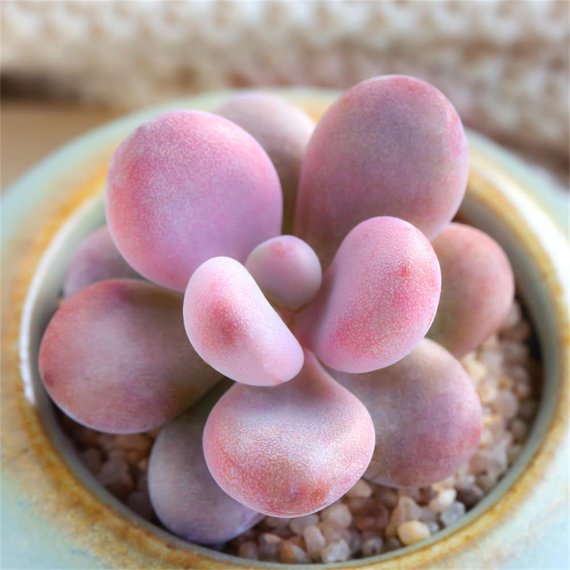Graptopetalum amethystinum (Rose) Walther is a popular succulent plant belonging to the Crassulaceae family, specifically the Sempervivum genus, and it exhibits characteristics of spring and autumn growth. Its leaves are charming, lacking sharp edges and instead presenting a rounded appearance, which adds to its cuteness. When temperatures drop and the temperature difference increases, the leaves of the Graptopetalum amethystinum (Rose) Walther turn pink, with a natural layer of thin powder on the surface, resembling pink pearls.
The Graptopetalum amethystinum (Rose) Walther has a relatively small plant size, with thick and fleshy leaves that can store a lot of water, thus possessing strong drought resistance. When planting, it's recommended to use small pots and soil with a high content of granular material. Soil with a high content of granular material has good air permeability and drainage, allowing water to evaporate quickly after watering and avoiding problems such as root rot caused by excessive watering. Using smaller pots helps the roots quickly absorb water from the pot, preventing water accumulation inside the pot, which keeps the soil moderately dry and promotes healthy root growth.
Graptopetalum amethystinum (Rose) Walthers prefer sunlight, especially after November, when the weather gets colder and the sun's ultraviolet rays weaken. Compared to semi-shade plants like orchids and peace lilies, Graptopetalum amethystinum (Rose) Walthers require more direct sunlight. Insufficient sunlight during winter can cause the Graptopetalum amethystinum (Rose) Walther to grow excessively long, affecting its adorable appearance. During autumn and winter, if the temperature on the balcony is above 5 degrees Celsius, it is advisable to place the Graptopetalum amethystinum (Rose) Walther there. On one hand, the balcony receives ample sunlight for the Graptopetalum amethystinum (Rose) Walther to bask in, and on the other hand, the temperature fluctuations on the balcony help the Graptopetalum amethystinum (Rose) Walther change color.
However, if the temperature drops below 5 degrees Celsius, do not place the Graptopetalum amethystinum (Rose) Walther on the balcony to avoid frostbite on the leaves. Additionally, after November, when the temperature is already low, the Graptopetalum amethystinum (Rose) Walther almost stops growing. Therefore, refrain from fertilizing it. Continuing to fertilize it will increase the burden on the roots, causing root burns, and in severe cases, the entire plant may die.
After the weather turns cold, the rate of evaporation of water in the pot decreases. Since Graptopetalum amethystinum (Rose) Walthers prefer a dry soil environment and dislike moisture, we need to reduce the frequency of watering after November. Wait until the potting soil is completely dry before watering again. You can determine whether watering is needed by observing whether the soil surface is dry and pale or by feeling the change in weight when lifting the pot. If the pot becomes significantly lighter, it means the water inside has been almost used up, and it's time to water. If there is no significant change in weight, it means there is still plenty of water inside, so watering is unnecessary.
Although Graptopetalum amethystinum (Rose) Walthers look delicate and adorable, they are actually very similar to other succulent varieties in terms of their need for sunlight. Inadequate sunlight can cause Graptopetalum amethystinum (Rose) Walther leaves to appear dull and grayish, and insufficient light can also lead to elongation and pest infestation. Conversely, with sufficient sunlight, Graptopetalum amethystinum (Rose) Walther leaves will be short and plump, and the entire plant will be more vigorous, with a more delicate color.
During the care of Graptopetalum amethystinum (Rose) Walthers, try to provide them with as much sunlight as possible, and don't be afraid of sunburn. Especially in spring and autumn when the sunlight intensity is not very strong, Graptopetalum amethystinum (Rose) Walthers can withstand 360-degree full-day sunlight exposure. In summer, if you are worried, you can take some shading measures around noon to avoid the strongest sunlight of the day, but don't miss the weak sunlight in the morning and evening. In winter, Graptopetalum amethystinum (Rose) Walthers also need plenty of sunlight, but we need to consider warmth first. As long as it doesn't freeze, let it bask in the sun more, and its leaf color will be brighter.
One of the most common problems Graptopetalum amethystinum (Rose) Walthers encounter in hot seasons is leaf blackening due to over-watering. This is closely related to our watering habits. If we water excessively, Graptopetalum amethystinum (Rose) Walthers may become over-watered, causing leaf wateriness or even more severe problems such as waterlogging in the pot, leading to root rot. Therefore, we should not be too eager to water Graptopetalum amethystinum (Rose) Walthers; instead, wait until the potting soil is completely dry before watering again. You can control watering once a month, meaning wait for 5-7 days after Graptopetalum amethystinum (Rose) Walther's potting soil is dry before watering again. This way, Graptopetalum amethystinum (Rose) Walthers will have a sense of water shortage, and when we water them, their roots will work harder to absorb water, and the leaves will store more water. As a result, the leaves of Graptopetalum amethystinum (Rose) Walthers will be fuller. Lastly, during summer's high temperatures, be sure to avoid water droplets from dripping onto Graptopetalum amethystinum (Rose) Walther leaves during watering. Otherwise, under high-temperature conditions, water droplets can easily damage Graptopetalum amethystinum (Rose) Walther leaves, causing leaf blackening.
During the care of Graptopetalum amethystinum (Rose) Walthers, try to provide them with an outdoor environment. Under the influence of wind and sunlight, Graptopetalum amethystinum (Rose) Walther leaves will be fuller and more delicate, and the plant's resistance will also be greatly enhanced. Whether it's the heat of summer or the cold of winter, Graptopetalum amethystinum (Rose) Walthers have a certain degree of self-regulation and adaptability. This not only greatly reduces the difficulty of their survival but also ensures their appearance remains attractive.
